Ever wondered how video-streaming services such as YouTube and Netflix fetch videos that you like? Or how Google and Facebook find stories that are interesting to you?
This is because these services are powered by Artificial Intelligence (AI) and Machine Learning (ML) algorithms – These algorithms are coded using a programming language in such a way that they can analyze your behavior at a granular level to find out your interests and preferences.
This article focuses on Python programming language and explains why it is the most effective AI and ML language.
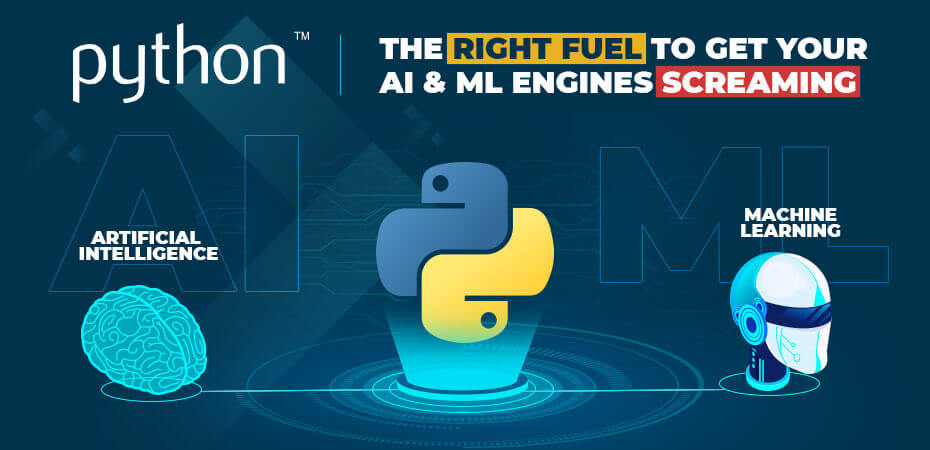
AI and ML are seeping into nearly every aspect of our lives, helping us in ways that augment our abilities and make us better at what we do. For instance, voice assistants such as Alexa, Google Assistant, Siri, and Cortana are transforming the way we work, study, and entertain ourselves.
As a matter of fact, AI and ML technologies aren’t just improving our lives, but, in some cases, also saving our lives. IBM’s Watson is the best example for this as it is detecting critical diseases and predicting ailments that veteran doctors could not do.
When it comes to the corporate world, AI and ML are poised to help enterprises make dramatic shifts in performance, business development, and customer service – With data being the lifeblood of business, AL and ML have open the doors for enterprises to analyze massive amounts of data, identify patterns, and extract critical insights that they can utilize to improve processes, drive profitability, and increase competitive advantage.
As a result, ML and AI software development are generating both interest & investment from forward-looking enterprises that hope to leverage the power of autonomous, intelligent solutions.
Gartner, a global research and advisory firm, predicts that by 2020, AI and ML technologies will become one of the top five investment prioritiesfor more than 30% of CIOs.
Tractica, a market intelligence firm that focuses on human interaction with technology, estimates that the annual global AI revenue will reach $118.6 Billion by 2025.
Developing artificial intelligence solutions can get tricky. This is where our expertise comes into picture.
If you are looking for expertise in AI or ML. We can help.
If you are thinking about diving into the AI or ML world, choosing the right programming language for your project is the key towards success.
Which Programming Language to Choose?
There are a number of languages to choose from (for e.g. C++, Java, JavaScript, Python, Lisp, R, Julia, and Scala) and it can get really confusing to pick one that will bring the most value to your project.
If you are into data science or manage projects that involve huge amount of data & information exchange, you will know that you need a language that has extensive set of libraries, good run time performance, robust ecosystem of supporting tools, and most importantly a large community of programmers.
Consider all this and still you are left with plenty of good choices.
So which language is the best fit?
Solving the Dilemma
AL and ML solutions are intelligent, i.e. they are different from traditional software applications. The focus here is more on in-depth research, data collection, and predictive analysis. Consequently, the language to be used here should be stable, flexible, and have a variety of tools.
One language that holds a special place among all is Python.
Python programming language is among developers’ favorite languages for AI and ML development because of its simplicity, shorter development time, consistent syntax, platform independence and access to a huge set of libraries. (Reasons are discussed in detail in the later section)
Moreover, as you get closer to understanding and working with Python app development, you will find it easy to handle massive amounts of data (i.e. data analysis and parsing required for AL and ML work well with Python, and its libraries).
GitHub, an online code hosting service provider and a collaboration platform for software developers, has pulled together the 10 most popular programming languages used for developing AI and ML based projects. The programming language that comes out on top is Python.
According to a survey by Kaggle, the world’s largest community of data scientists and machine learners, Python emerged as the most popular programming language.
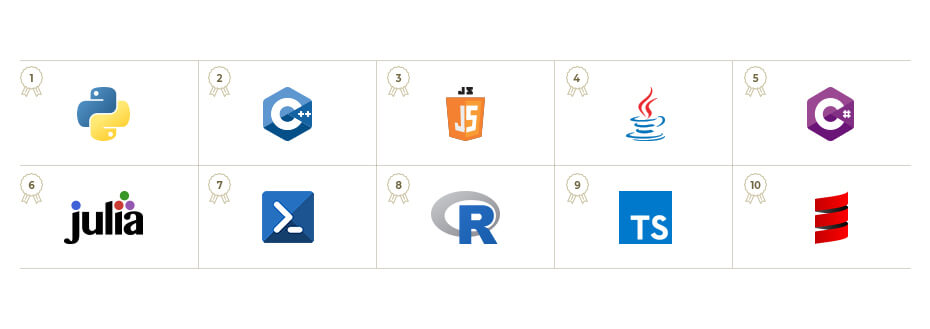 Source: GitHub
Source: GitHub
Looking to power your innovative artificial intelligence solution with Python?
We can help.
Before we get into the core reasons of why Python is the most suitable programming language for AI and ML, let’s have brief overview of Python.
Python: The Fastest-Growing Programming Language
Python is a multi-paradigm programming language that has been created as a more straightforward, concise, and easy-to-understand option to other major languages such as C++ and Java.
In fact, it is designed to be highly standardized, with a clear protocol for any task. Furthermore, it requires minimal to no effort for casting a sophisticated patchwork. This is why it is the first choice of many software developers, analysts, cyber-security professionals,data scientists, and machine learning engineers.
The term “fastest-growing” can be hard to define precisely, but Python has a solid claim to being the fastest-growing major programming language. This can be observed in the Stack Overflow’s survey about Python’s growth in high-income countries.
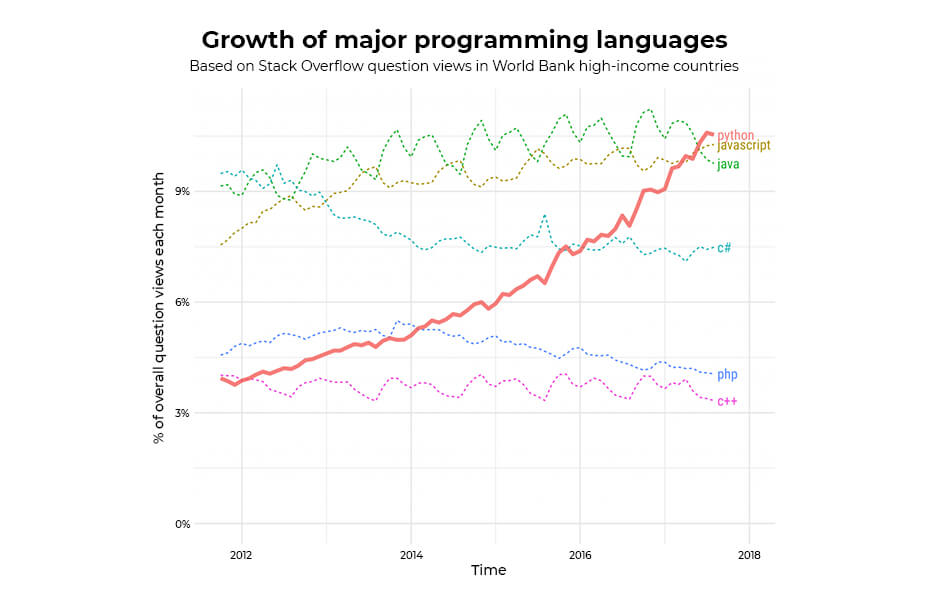
According to the TIOBE Programming Community Index, Java is the most used programming language.However, when we turn our eyes on the third position, we find Python. This is because it has seen amazing growth in recent years.
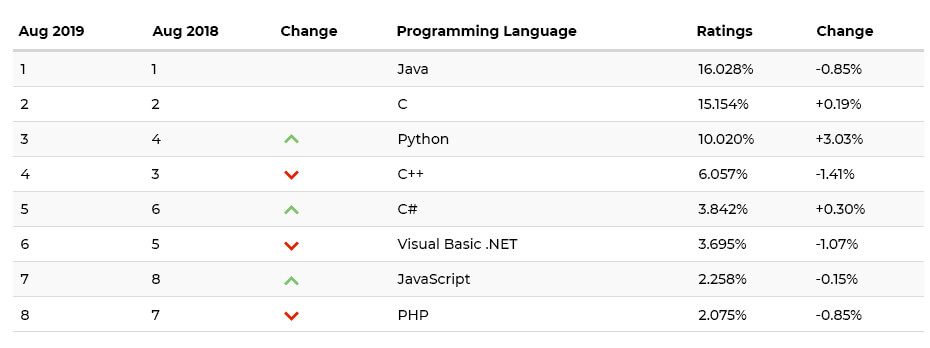
The TIOBE Index claimed that Python might overtake Java and C as the most popular language in a few years.
A more recent survey by Stack Overflow (i.e.Developer Survey Results’19) mentions that Python is the fastest-growing major programming language, edging out Java, and stands as the second most loved language (behind Rust).
The primary reason for Python’s steady climb is because of its increased usage in developing AI and ML solutions.
Some of the top brands that utilize Python for AI and ML:

Python for AI and ML: Why?
- Large Set of Libraries
- Code Simplicity
- Platform Independence
- Community Support
- Visualization Ability
- Flexibility
When you code with Python programming language, you get a well-structured & tested environment where you can quickly turn your ideas into action. Also, it takes less coding and time to solve complex computational problems.
With that said, let us go through the key reasons for using Python for AI and ML:
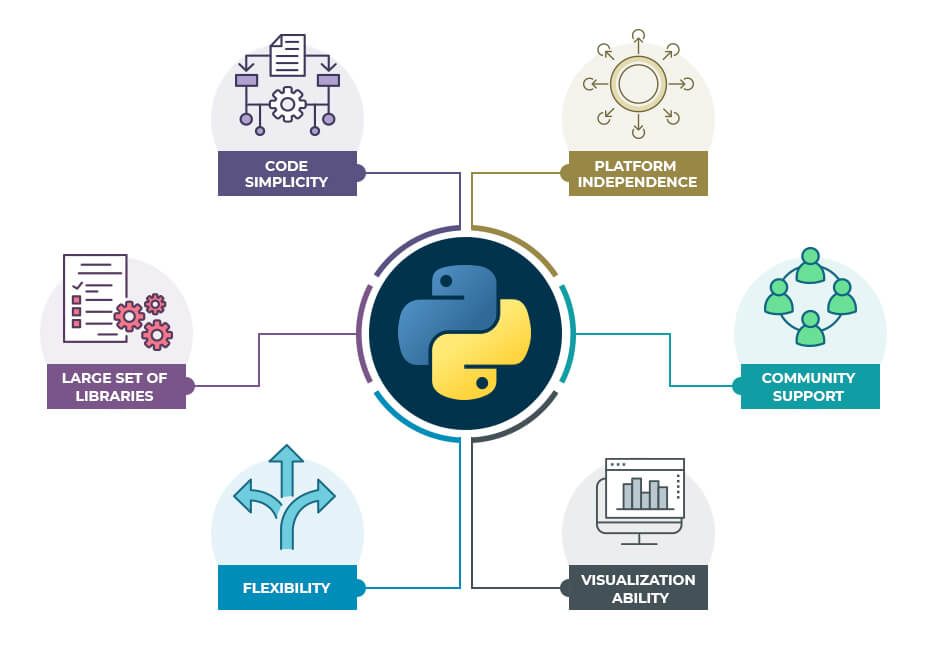
1) Extensive selection of libraries
Libraries refer to the collection of functions and pre-written codes – A solid set of libraries eliminates the need to rewrite lines & lines of code when performing complicated tasks such as solving a tricky algorithm problem.
A great library ecosystem is one of the main reasons why Python is the most preferred language for AI and ML based projects.Python libraries provide developers with all the basic items required for AI and ML development so that they don’t have to code everything from the scratch.
Here are some of the most commonly used basic Python libraries in AI and ML:
- Pandas for general-purpose data analysis
- NumPy for high-performance scientific calculation and data analysis
- TensorFlow for high-performance numerical computation
- SciPy for advanced computation
- Scikit-learn for handling ML algorithms (like clustering, decision trees, linear and logistic regressions, and classification)
- Keras for building and designing a neural network
- Matplotlib for data visualization (i.e. developing 2D plots, histograms, charts, and other forms of visualization)
- Natural Language Toolkit (NLTK) for working with computational linguistics and natural language recognition& processing
- Scikit-image for image processing& analysis
- PyBrain for implementing machine learning algorithms and architectures ranging from areas such as supervised learning and reinforcement learning
- StatsModels for data exploration, statistical model estimation, and performing statistical tests
2) Code simplicity
Coding with Python is super easy to learn and implement. This is because it utilizes English like language with self-explanatory commands, minimum syntactical rules, and lots of white spaces for content legibility.
Many developers describe the syntax of Python as math-like (i.e. semantic presentation is similar to most of the mathematical concepts) that is suitable for AI and ML.
While building models for AI and ML involve complex algorithms and versatile workflows, Python’s simplicity allows developers to write reliable codes – Developers are able to put all their efforts into coding rather than focusing on the technical nuances.
3) High flexibility
Python is a great choice for AI and ML as it is very flexible:
- Developers can utilize different algorithms and languages along with Python (a majority of code can be checked in the IDE)
- It works as an ideal backend and is suitable for linking different data structures together
- It provides the option to choose between OOPs and scripting
4) Platform independence
One of the biggest advantages of Python is its ability to work on a variety of operating systems such as Windows, Linux, and MacOS.
Developers can write and implement the code on one platform and run it on another with minimal changes i.e. no major changes are required to migrate the source code.
5) Constant support from the developer community
Python is loved by millions of developers worldwide. This is obvious by seeing the communities, groups, and forums that answer queries about this language (e.g.Python.org, Stack Overflow and GitHub).
The presence of a huge and active community of developers can help you in any and every stage of a software development life cycle.
6) Availability of great visualization options
As mentioned above, Python supports a variety of pre-built libraries. Some of them act as visualization tools.
Due to this, developers get the opportunity to represent data through histograms and charts. This is easily understandable to the non-technical people.
This is pretty useful in cases of AI and ML. For instance, libraries like Matplotlib are utilized to build histograms, charts, and plots for better data comprehension, effective presentation, and visualization.
Bottom Line
AI and ML have a profound effect in the world we live in, with new solutions coming up day after day. Enterprises have realized that there is no better time than now to invest in these technologies.With its amazing set of libraries, simple & clean coding format, fast prototyping, outstanding flexibility, and huge community support,Python makes the development process of AI and ML based projects a lot easier, fast, and budget-friendly.
Considering all the advantages that Python offers, the decision of which programming language to choose for AI and ML is obvious.
Planning to implement AI with a custom Python-based solution?
We can help!



